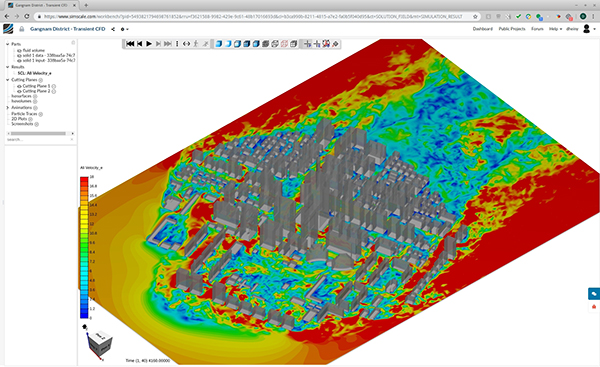SimScale Releases a GPU-Based Lattice Boltzmann Solver
Pacefish is a completely new implementation of the Lattice-Boltzmann method (LBM) tailored to the parallel architecture of GPUs.

Wind analysis (velocity) in Gangnam District (South Korea) created end-to-end via a web browser with SimScale and simulated according to Korean Building Code 2016. Image courtesy of Business Wire.
Latest News
December 20, 2018
SimScale has released a new GPU-based solver using the Lattice-Boltzmann method (LBM), which pairs accuracy with speed and is accessible via cloud, according to the company. Partnering with Numeric Systems GmbH to develop this feature through the tool Pacefish, the cloud-based simulation company, has reduced running times for transient simulations from weeks and days to hours and minutes.
Developed by Numeric Systems GmbH, Pacefish is a completely new implementation of the Lattice-Boltzmann method (LBM) tailored to the parallel architecture of GPUs. Its ability to efficiently run on multiple GPUs in parallel enables fasterturnaround times, the company reports. Moreover, Pacefish supports several turbulence models such as Smagorinsky LES, hybrid uRANS-LES SST-DDES and SST-IDDES and uRANS k-omega SST.
SimScale products are available to free and paid (professional and enterprise) subscribers. The new GPU-accelerated Pacefish solver is only available to paid subscribers, says Netty Zaharia, SimScale's marketing manager.
“Customers purchase a base subscription with a computing quota included,” explains Zaharia. “But with Pacefish, it's GPU hours instead of CPU hours. Additional computing quota beyond the included amount can be purchased on-demand later.”
In its first release, SimScale’s new solver enables virtual wind tunnel analysis for wind loads on buildings, pedestrian wind safety, automotive aerodynamics and other external flow applications. Several validation projects have been carried out, comparing the generated simulation results with wind tunnel measurement data and will be shown in this webinar dedicated to the release.
As with every solver on SimScale, users can benefit from this technology without specific hardware requirements related to graphics cards, data storage or CPU performance. Relying on cloud computing, users can run industrial-scale external flow analysis with hundreds of millions of cells within just a few hours computing time on up to 16 GPUs.
SimScale uses Amazon's AWS computing resources to support its cloud-hosted simulation products, according to Zaharia.
“The accurate analysis of transient flows has historically been fraught with very long computing times and high up-front costs to yield realistic results. With the release of this new Lattice-Boltzmann solver, CFD engineers no longer need to choose between speed and accuracy—and on top of that, can access it with the convenience of an entirely web-based workflow. We’re very excited to see our customers seize the new opportunities this technology is opening up,” says David Heiny, CEO and co-founder of SimScale.
Sources: Press materials received from the company.
More Info
More SimScale Coverage

Subscribe to our FREE magazine, FREE email newsletters or both!
Latest News
About the Author
DE’s editors contribute news and new product announcements to Digital Engineering.
Press releases may be sent to them via [email protected].







